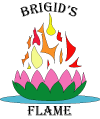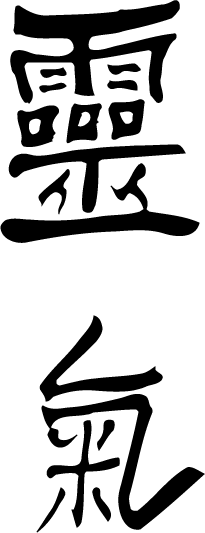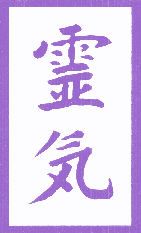
THE SACRED
USUI REIKI SYMBOLS
I received my first reiki attunement in November 2003 and my last in January 2006. After my first reiki attunement, I dedicated a lot of time to researching and studying reiki before deciding to move on with my training. One of the major discussions I came across during that time was the debate about the reiki symbols - in particular whether they should be kept secret or not. There were some people who felt that there was no need to keep the symbols a big secret and were willing to publish them in their books (most notably Diane Stein). I personally felt it was silly to keep the symbols a secret as it caused more of desire to find out what was the big deal with the symbols. The first reiki book I saw the symbols in was by Carmen Fernandez and later I saw the symbols in Diane Stein's notable, Essential Reiki. Fernandez' book had only the second level reiki symbols depicted while Stein included the master level symbols. Stein also compared what she was using with what she called the "Usui Traditional Reiki" symbols (that is, the symbols as used by the Reiki Alliance, the reiki organization based on Hawayo Takata's teachings). As I looked at these symbols for the first time, I could not help noticing that two of the "Usui Traditional Reiki" symbols looked funny enough like a child's distorted scribbling of Chinese characters! Reiki is Japanese, but the Japanese use the Chinese writing system (referred to as "kanji" in Japan) along with their own and knowing this, I set out to prove my suspicions that at least two of these symbols held in such secret reservation are simply Chinese/Japanese words used in everyday language and weren't necessarily a big secret (though as I will explain below, the phrases the two symbols represent are used in a sacred manner). As it turned out, I was correct in my suspicions.
All of this research happened before I took my second level reiki course in April 2005 - I wanted to know a bit more about what I was getting into if I was going to continue with studying reiki. Unfortunately, by the time I took my second level reiki course, I knew a bit more than my teacher at that time about the origins or reiki, and especially about the origins of the reiki symbols. I didn't want to hijack her class so I pretty much held my breath then about the reiki symbols (although, when we were practising drawing the symbols, I did draw the one symbol based on the Japanese kanji according to the Chinese/Japanese system of writing). I was pretty much there to get my attunement and to see what Western new age practices were tossed in with reiki. Don't get me wrong though! There isn't anything particularly wrong with the new age practices that are tossed in, but what was tossed in is, frankly, based on magical theory (though, of course, the people teaching it didn't know it, and didn't know that Mikao Usui, the first teacher of reiki, never practiced that as the new age practices were tossed in at some point predominantly by people who are now grouped under the Usui/Tibetan reiki tradition). In any case, the teacher for my second level was pretty good despite her naivety about magical practices and I did take her third/master level training (which as it turned out was Usui/Tibetan and the attunements she gave me were from the Usui/Tibetan tradition).
My training now complete, I reviewed what I learned in my second and third level reiki courses with what I learned about the Japanese tradition of reiki (as by this time, I had started reading books by Frank Arjava Petter, who had gone to teach reiki in Japan and was surprised to meet real Japanese reiki practitioners who retained some knowledge of what Usui taught). Then, I started working on writing my own reiki manuals comprising an assimilation of what I learned from Western reiki and what I learned about Japanese reiki. That was in 2006. Now, just three years later, things in the reiki world have changed - including the overall attitude about the reiki symbols (that being said, there are still a lot of issues that need to be worked out in the greater reiki community). Generally, I do not believe that the symbols need to be kept secret. I believe this more so now than before as there are more people exposed (and attuned!) to reiki. It may well be that almost everyone will be attuned to reiki. I do not believe the high level of secrecy does reiki and its practitioners any benefit, nor was this ever the intention of Usui. Usui wanted to promote reiki to everyone and felt that it was a gift that needed to be shared. As already mentioned, two of the reiki symbols used are simply kanji. Granted, the meaning of the phrases those kanji make up are used in a sacred manner, but in general each kanji comprising the two symbols are simply common words. Because the kanji are simply common words, I do not believe we need to keep these two symbols secret. The other two symbols are thought to come from Sanskrit (although one may actually have Shinto origins instead). All these symbols may be sacred, but they are not secret. In my humble opinion, I think that a misunderstanding of the sacredness of the symbols is what drives some to keep the symbols secret. They fear that upon revealing the symbols to the "non-initiate", the symbols will lose their sacredness as if the symbols themselves have some hidden power. I do not believe this about symbols in general, and in my reiki level two course, I discuss the purpose of the symbols as simple communication devices and tools for focusing. The tool may help you accomplish something, but that does not mean that the tool has power - it is you who are using the tool and therefore, it is you who has the power.
Following is an excerpt from my reiki level two manual about the reiki symbols:
"In addition, two of the symbols used in reiki are comprised of common kanji (Japanese words). These two symbols communicate a very specific idea or meaning that may not be easily understood by the common Japanese person even if they read the kanji. They may know what each kanji means, but they may not understand fully the philosophical concept behind the whole symbol.
I have mentioned that the symbols are tools for focusing and do not hold any power. Reiki symbols are no different from any other symbol. In fact, two of them are thought to come from Sanskrit. The symbols in reiki are not the "be all and end all" of reiki, despite the fact that some people place extremely high importance on them. The symbols do not give reiki and do not contain reiki energy - you do. This is why the attunements are required to give reiki. You become a channel for reiki and then you can use the symbols as aids. It is not the reverse. The symbols are not reiki energy and you do not help the symbols give reiki. Recall that symbols are a means of communication. The reiki symbols are a way to communicate and connect with reiki. The symbols are used to aid you in focusing the energy on what is needed. The symbols are not more important than the act of giving reiki. When reiki is first taught, some of you may find that you have trouble focusing when giving a reiki treatment. This is when using the symbols is helpful. Even if you are not having much difficulty focusing during a reiki treatment, the symbols will be helpful for specific types of treatment, such as mental and emotional healing and distant healing. The symbols are also used in meditation to connect with reiki on a regular basis. The "names" of the symbols are really the mantras that are associated with the symbols."
Having now discussed why I do not consider the symbols secret, I will now discuss each symbol.
THE FIRST SYMBOL
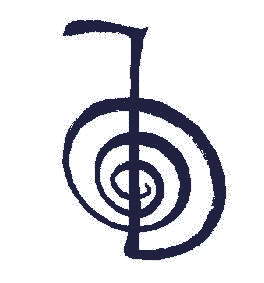
The name and mantra for this symbol is "choku rei" (pronounced "cho koo ray"). The simplest meaning for this symbol is "power" and it is referred to by many as the "power symbol". The name and mantra for this symbol can be written in kanji, though it is not known which kanji should be used. This symbol is used to increase the flow of reiki energy or the power to heal. This symbol is considered to be the activator and can be thought of as the "light switch" symbol, as in "turn the power on" (the power being reiki). This symbol is often used whenever one or both of the other two symbols are used, as it is said it will help activate the energy of the other symbols. I believe it is erroneous to state that this symbol activates the others. Each symbol can be used by itself since it is not the symbol that carries reiki, but the practitioner. This symbol can be used with the other symbols to give an added "boost" of energy if the person wishes, but it is not required for use of the other symbols. I have seen variations of this symbol. Fernandez turns this symbol upside-down and Stein uses the mirror image of this symbol. Stein feels that the counter-clockwise direction does not increase the reiki energy while the clockwise one does. This has not been my experience or the experience of others who use the counter-clockwise version. In fact, it is likely that the symbol works either way! Remember that the symbol does not contain reiki energy - you do. Stein's idea comes from her practices in Wicca where a counter-clockwise direction is generally considered to connect with negative or decreasing or banishing energies. However, it is the earth that rotates counter-clockwise on its axis making it appear as if the sun moves clockwise. Thus, a clockwise direction properly connects with solar energy rather than the earth. I personally prefer the symbol as it is shown above, not because it is supposedly the "traditional Usui" version, but because of the alignment with earth energy. This provides a sense of balance when using reiki as reiki enters through the head. Using a symbol connected to earth energy is helpful in keeping reiki energy grounded and stable.
THE SECOND SYMBOL
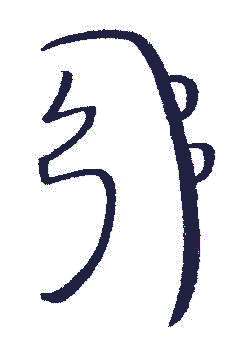
The name and mantra for this symbol is "sei hei ki" (pronounced "say hay key"). The simplest meaning of this symbol is "harmony". It can be called the "harmony symbol", the "freedom symbol", or the "release symbol". It is most often referred to as the "mental symbol" or "mental healing symbol". Some call it the "emotion symbol" or the "mental emotional symbol". This symbol is used specifically for mental and emotional healing. Like the first symbol, the name and mantra for this one can be written in kanji. Based on the kanji that would be used, a translation is "peace and serenity from the spirit". This symbol will help harmonize the body with the mind and prepare the body for healing. It helps purify and clear out negativity and unwanted thoughts and feelings. It is a symbol of release. Using this symbol is good for healing as it helps get to the root cause of an illness or "dis-ease" ("disease" as used here refers to anything that causes unease). This symbol is used to heal addictions, as addictions are a mental and emotional condition as well as a physical one. Some addictions are not even physical but are instead mental and emotional conditions, although the person may not be aware of it. Many have linked the above symbol with the hrih, a symbol from Sanskrit adopted into Buddhism. In fact, many think that the harmony symbol is simply a variation of the hrih symbol. The hrih is associated with the Boddhisattva Avalokitesvara who is known as the goddess Kannon in Japan, the goddess Kuan Yin1 in China, and the goddess Tara in Tibet. This deity is associated with love, compassion, and healing and is a symbol for release from suffering. Given that this goddess dedicated herself to releasing others from suffering, it is no surprise that the hrih symbol (only one of her symbols - another of her symbols is the lotus) was adopted into reiki. Don't be surprised if you begin to sense a presence from this goddess when you are using this symbol. If you are unfamiliar with deity energy, the feeling may come as a surprise. Do not be frightened of it though (actually, you should enjoy the feel of this goddess' energy); it is likely Kuan Yin (or Kannon) is just lending a healing hand to your work. Some think this symbol relates to the emotional while the third one relates to the mental. I do not think that the meanings of the symbols are so simple as to be able to make that distinction. Both this symbol and the third symbol relate to the emotional and the mental. One difference between these two symbols is that this one is for releasing emotions and thoughts while the next is for changing emotions and thoughts or changing consciousness. Another difference is that the next symbol carries more meaning relating to time and distance and can therefore be used for distant healing. I was taught to use the harmony symbol only if I felt it was needed; however, it probably could be used more often in healing work. The only caution that should be stated is that the energy represented by this symbol can be quite powerful and someone may respond strongly in a healing session. Be aware of this and make sure you are prepared to deal with the person's fragile mental and emotional state.
THE THIRD SYMBOL

This symbol is commonly called the "distant symbol". This symbol is not really a symbol, but a composition of five kanji. The kanji are written in a stylized format where some kanji overlap another. The kanji compose the mantra "hon sha ze sho nen" (pronounced "hawn shah zay sho nen"). The simplest meaning for this is "connection" as in connection with the original source or connecting beyond time and distance; thus, it may simply be called the "connection symbol". It also carries the idea of connection with "right thought". It has been used primarily for distant healing in Western Reiki, but can be used for mental healing as well because the symbol injects "right thought" or "right thinking". These kanji have been translated in a variety of ways. A translation that falls closer to the meaning of the kanji is "the righteous person may correct all thoughts" (although this neglects the meaning of the top kanji). "Right consciousness is the root of everything" is the most accurate translation to date. This is the translation native Japanese and Chinese speakers have given the kanji. (Note that the characters carry the same meaning in Chinese and Japanese. Japan adopted the Chinese writing system, but the pronunciations of the characters are often different.) To understand why this translation is the most accurate, it helps to look at each kanji separately along with their definitions. The following definitions are from an online Chinese dictionary.2

The first kanji ("hon") is a noun that means "stem, root, basis, origin, or book".3 The Japanese definition is "source" or "origin".4

The second kanji ("sha") is a pronoun that means "person or thing".5 The Japanese definition is "person".

The third kanji ("ze") is an adjective that means "correct or right".6 The Japanese definition is "right" or "just".

The fourth kanji ("sho") is an adjective that means "proper, right, just, or fair", and a verb that means to "rectify or correct".7 The Japanese definition is "correct" or "right".

The fifth kanji ("nen") is a verb that means "think of, miss, remember, or study".8 The Japanese definition is "thought", "idea", or "wish".
From this, you can see that the translation "right consciousness is the root of everything" carries more connotations and meaning than it at first seems. You can also see why this symbol deals with both the emotional and the mental. The last kanji implies active thinking of something holding it close to you emotionally.
There are probably more variations of this symbol than the previous two. There are many different variations of this symbol because it is comprised of kanji. Writing kanji is a skill that needs to be practiced, even by native Chinese and Japanese. Kanji writing or Chinese calligraphy is an art form and is not as easy to write as English letters. Thus, when reiki was first taught in North America, many were unfamiliar with writing kanji or with Chinese calligraphy. Each line (called a stroke) must be written in a specified order. Since reiki students are not taught the rules behind the stroke order (they were expected to simply memorize the stroke order) or are unfamiliar with kanji, they may easily make mistakes in writing the kanji and may end up with something that looks completely different than what they were shown. Here is one variation. It is a variation that is closest to the one shown above.9 To learn how to write the kanji for "hon sha ze sho nen" (and also for "dai ko myo" below), see How to Write Chinese Characters".
I was taught to use this symbol only for distant healing; however, it can be used for in-person treatments as it helps change the emotional and the mental state of the person. As with the second symbol, be aware that when using this symbol you need to be ready to help the person through any strong emotions or any major changes. This symbol can be used combined with the second one for a quite powerful healing. Because the second symbol is about releasing and this one is about changing emotions and thoughts, using both combined seems to provide a natural cycle for healing. First the release and then the change.
THE FOURTH SYMBOL

This symbol is commonly called the "master symbol" or "personal mastery symbol". As with the third symbol, this symbol is not really a symbol, but a composition of three kanji. Unlike the third symbol though, the kanji in this symbol do not overlap. The kanji compose the mantra "dai ko myo". Simply translated, it means "great bright light" or "great shining light". It may be interpreted as "great enlightenment". It represents the divine and the source for reiki. This symbol may simply be called the "satori symbol". This symbol is used in Buddhism and is found written in Buddhist temples; therefore, although it is sacred, it is not secret. Japanese people who are not devoted Buddhists recognize these three kanji together. Modern Japanese would pronounce it as "dai ko mei" instead. This symbol was chosen because Usui knew its inner meaning. Some say this symbol means "Great Being of the Universe, shine on me" or "Treasure House of the Great Beaming Light", but these are simply embellished translations of "great bright light". Like the third symbol, we can look at the meaning of each kanji separately. The definitions are again taken from an online Chinese dictionary.10

The first kanji ("dai") is an adjective meaning "big, large" or "great, grand". It is an adverb meaning "greatly".11

The second kanji ("ko") is a noun meaning "light". It is also an adjective meaning "smooth, glossy". It is also an adverb meaning "merely, purely" or "completely".12

The third kanji ("myo") is an adjective meaning "bright, light" or "clear, evident". It is also a verb meaning to "understand, know".13
From this you can clearly see that "dai ko myo" means "great bright light". The Japanese definitions of the kanji are the same as above. To draw this symbol, you should follow the rules from "How to Write Chinese Characters" as directed above for the third symbol. Most variations of this symbol are badly written versions of the kanji, which are properly shown above. This is the same issue as with the third symbol. In Essential Reiki, Stein has a variation in which the third kanji of this symbol is just a double of the kanji on the right in "myo". Essentially it looks like the kanji for "moon moon", which is unfortunate because it leaves out the kanji for sun in the whole symbol. The sun kanji is significant to the symbol as it relates to the idea of enlightenment. Stein does not actually use this symbol as she mistakenly thinks of another symbol as a replacement for dai ko myo, when in fact, her replacement has a different function than dai ko myo. The symbol she uses as "dai ko myo" is from the Usui/Tibetan tradition, and when she was given the symbol she was not taught its meaning nor given its correct name, dumo. The Usui/Tibetan tradition uses dumo to reflect the idea of mastery along with dai ko myo (although, their version of dai ko myo has been distorted from the actual kanji above). To confuse the issues further, Stein has drawn her "dai ko myo" (dumo) differently than the Usui/Tibetan tradition, turning the symbol clockwise 90 degrees and emphasizing the spiral portion of the symbol, as she associates the Usui/Tibetan symbol with the idea of the eternal goddess in paganism and goddess-centered spirituality. There is another symbol also called "dai ko myo" used in Barbara Weber Ray's organization, The Radiance Technique. This symbol is quite similar to dumo. Aside from Stein and Ray, there does not seem to be too many replacements for this symbol nor as many variations as there is with the third symbol. The fourth symbol is predominantly used during each attunement to connect you to reiki and may be used for treatments as well along with the other symbols. In fact, it may be used instead of any of the other symbols as this symbol represents the source for reiki. Use your intuition to guide you in using this symbol. Meditation on it may illuminate and help you to understand reiki.
Note that you can use all four symbols in healing or not. That is to say that you do not need the symbols to give reiki healing - after all, you can give reiki healing after the Reiki One attunement. Remember that the symbols are taught as a tool to aid in focusing your energy. Yes, it can often help healing, but really it's only because it helps direct you to the healing that is needed. Get to know the symbols well and use them often enough to help you focus your energy, but do not become dependent on the symbols that they become a crutch.
This has just been a brief discussion about the reiki symbols and some of the issues that surround them. As I said, I do not consider the symbols to be secret. They are sacred though and you should try to understand the meaning of the symbols you are using. Along those lines I think it is important that you also understand the origins of the symbols themselves. This is what led me to look at how the symbols are being drawn. The origins of the first symbol are still a little unclear to me. As of now, I have heard that the first symbol comes from Shinto and not Sanskrit as I originally thought when I wrote my Reiki Two manual (since then I have picked up a language book on Sanskrit and I have to say I don't think the first symbol comes from Sanskrit as it doesn't fit with the overall writing system). The second symbol is definitely from Sanskrit, though it is quite a distorted version of the Sanskrit, hrih. Like Chinese and Japanese, you can learn how to write Sanskrit and eventually write the second symbol as it is meant to be written (I might well be working on this at some point and change the second symbol that I use to the original Sanskrit form). The third and fourth symbols are definitely Chinese/Japanese in origin. Knowing the origins of these two symbols, I have opted to write them as a Chinese or Japanese scholar would. This is, of course, a big issue for some Western reiki practitioners and teachers as they were taught not to modify the symbols, but that may have only been because Takata thought she knew the correct versions without realizing that she distorted the symbols or that her students would distort the symbols unknowingly (since they are not adept in writing Chinese/Japanese or Sanskrit). While I do not place an over-emphasis on using symbols in my reiki practice, I do feel that when using them I should be writing the symbols the way they should be written. While I also do agree that when giving reiki for healing or for attunement purposes, it is the intent that matters (this is why I teach that you can give reiki or do attunements without symbols!), I do feel that part of your intent should be to write the symbols as close to their original form as possible if you are using them. There is an aesthetic and a beauty about the symbols that is felt when they are drawn in their original form. If intent is what matters then it is also important that we intend to write the "symbols" as they should be written if we are using them, especially now since there is enough evidence to prove to us what the original form of the "symbols" should be; to do otherwise is simply willful ignorance (which is different than not knowing at all). The fact that dai ko myo was not passed on in its original form may be why some people did not like using it - they may have felt that something was "missing" and that it wasn't "natural" - and then opted to use the Usui/Tibetan symbol, dumo, instead (though there is nothing wrong with using other symbols from other systems if you wish to and if you understand their purpose, but again, I would advise against becoming too dependant on symbols and using them as a crutch). Basically, I do not understand why people do not write the symbols as they are supposed to be written if we know how they are supposed to be written. It seems silly to keep to "tradition" just because we are told to, every tradition should still have good reasons for doing things a certain way. Reiki as Usui used it was simple and easy. There were few rules. It was straightforward and uncomplicated. This is how it should be. Yes, it should be adaptable when needed, but it shouldn't adapt to the point of unnecessary complication. "Keep it simple, silly."14
For your own use and study, you may download a pdf file with the Usui reiki symbols I currently use (as I mentioned, I may be revising the second symbol at some future date to reflect the correct Sanskrit writing).
FOOTNOTES
1. You can read about this goddess in Myths and Legends of China by E.T.C. Werner. William Lee Rand also has a short article about Kuan Yin and Karuna Reiki on his website (http://www.reiki.org/reikinews/KuanYinandKarunaReiki.html).
2. From http://zhongwen.com/.
3. From http://zhongwen.com/d/165/d187.htm.
4. See Essential Kanji by P. G. O'Neill for the Japanese definitions of the kanji given in this article.
5. From http://zhongwen.com/d/170/d204.htm.
6. From http://zhongwen.com/d/172/d79.htm.
7. From http://zhongwen.com/d/165/d191.htm.
8. From http://zhongwen.com/d/169/d192.htm.
9. You can see more variations at http://www.geocities.com/fascin8or/reiki_hszsn_various.htm.
10. See note 2.
11. From http://zhongwen.com/d/164/d106.htm.
12. From http://zhongwen.com/d/165/d250.htm.
13. From http://zhongwen.com/d/169/d250.htm.
14. Curious about the origins of the KISS principle? See http://en.wikipedia.org/wiki/KISS_principle.
LIST OF SOURCES
A substantial list of sources regarding my overall reiki research is provided in my reiki manuals. This article is based on information in my Reiki Two and Reiki Three manuals. Please see "Reiki Courses" for more information about my reiki program.
Copyright C.J. Chow June 2009
